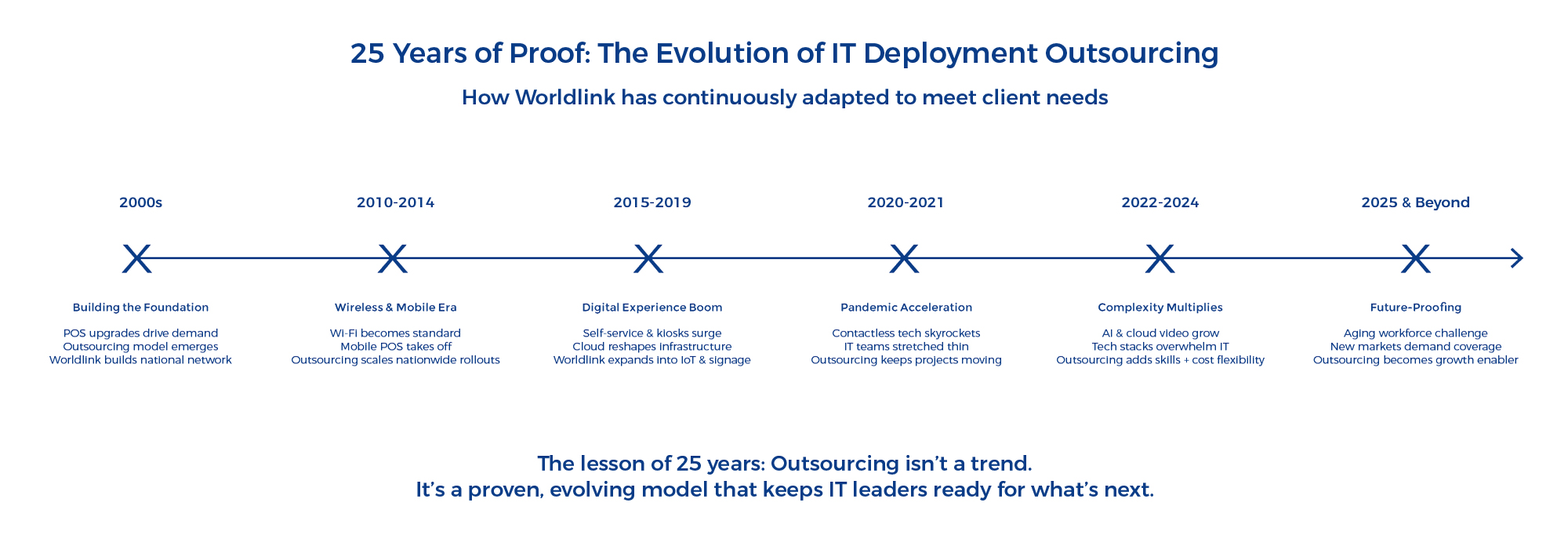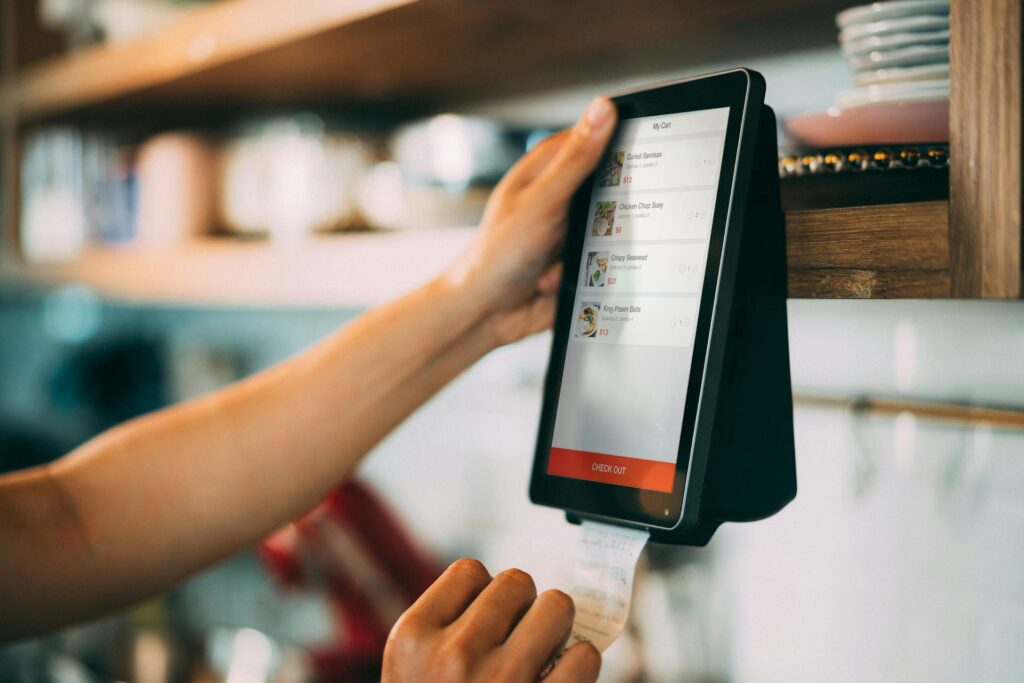When CIOs and IT leaders consider outsourcing IT deployments, one question often rises to the top:
“How do I know this model will really work for us?”
It’s a fair question. Technology deployments touch mission-critical systems, frontline employees, and ultimately, customers. Mistakes cost more than dollars — they risk downtime, reputation, and even customer trust. Entrusting that work to an external provider can feel like a leap of faith.
But here’s the reality: outsourcing IT deployment isn’t a new experiment. It’s a proven model — one that companies like Worldlink have been perfecting for over 25 years. That quarter-century of experience isn’t just a milestone. It’s proof that outsourcing works when it’s built on continuous evolution.
The Test of Time in Field Services
The field services industry is taxing. A company can’t survive without delivering results. Worldlink’s 25 years in IT deployment span a period of massive change:
-
-
- The rise of mobile and wireless technologies in retail and restaurants.
- The shift from on-premise systems to cloud platforms.
- The growing use of kiosks, self-service devices, and smart endpoints.
- The integration of IoT, AI, and security systems into the store and restaurant footprint.
-
Each wave of change required new skills, new processes, and new approaches to workforce management. Companies that couldn’t adapt didn’t last. Worldlink did because it treated each project as an opportunity to refine, learn, and improve.
Lessons Learned from Thousands of Deployments
Over 25 years, Worldlink has completed projects ranging from single-store pilots to nationwide rollouts. Each deployment added to a body of knowledge that no single in-house team could replicate at scale.
Some lessons came the hard way:
-
-
- Vendor coordination is everything. Technology rollouts often depend on multiple providers. If timelines aren’t aligned, skilled staff end up sitting idle and that’s a costly mistake. Over time, Worldlink developed orchestration practices to minimize wasted time and keep deployments moving smoothly.
- Geography changes the game. Deploying in a flagship New York City store is not the same as deploying in a suburban strip mall or a regional town. Travel, logistics, and site conditions vary widely. A national workforce built for flexibility became critical.
- Efficiency matters more than hours logged. Internal teams often spend more time than necessary on-site, simply because they’re already there. By contrast, outsourced teams can be scheduled precisely when needed, dramatically reducing soft costs like idle time.
- Planning can’t anticipate everything. Even the most thorough scope of work leaves room for surprises. From construction delays to unexpected infrastructure issues, a deployment partner must be ready to adapt in real time. Experience helps you develop the agility to adjust without derailing the project.
-
These lessons have been repeated, refined, and embedded into our processes.
Adapting to Workforce Realities
One of the biggest challenges in retail technology deployment services today is workforce sustainability. The national pool of skilled field technicians is aging, while younger workers often enter with different expectations about training, mobility, and compensation.
An internal IT team, no matter how strong, can’t maintain deep expertise in every technology discipline. Worldlink’s model works because it absorbs this complexity on behalf of its clients. By continuously recruiting, training, and distributing its workforce, Worldlink ensures coverage where and when it’s needed.
In other words: while your internal team focuses on strategy, Worldlink ensures you have the right skilled hands in the right location to execute.
Technology Never Stops Changing
Twenty-five years ago, a restaurant deployment might have meant rolling out new POS terminals and a back-office server. Today, that same location could involve:
-
-
- POS upgrades.
- Wireless infrastructure.
- Digital menu boards.
- Kitchen display systems.
- Security cameras and access control.
- Self-service kiosks.
- Cloud integration.
- AI-enabled monitoring and analytics.
- POS upgrades.
-
No single IT department can master all of these technologies at once — at least not without draining resources from other mission-critical priorities. Outsourcing works because it provides access to specialists who already know the systems and have deployed them elsewhere.
Instead of reinventing the wheel internally, brands tap into a library of expertise.
The Economic Proof Point
Of course, cost remains a major driver for retail technology deployment services decisions. But after 25 years, one reality has become clear: the economic value isn’t only in the hourly rates. It’s in eliminating the hidden soft costs that plague in-house deployments:
-
-
- Paying salaried staff to travel long distances and spend days idle while waiting for other vendors.
- Pulling IT leaders away from strategic projects to manage tactical fieldwork.
- Covering overtime and last-minute travel for internal staff already stretched too thin.
-
Worldlink’s experience proves that outsourcing provides a more flexible cost model. By aligning labor precisely to demand, it minimizes waste while giving brands nationwide reach without permanent overhead.
Trust Built Over Decades
Perhaps the most compelling proof point isn’t in the hours saved or the costs reduced — it’s in the partnerships built. Over 25 years, Worldlink has become more than a vendor to many of its clients. It has become an extension of their IT teams, trusted to represent the brand in the field and to deliver with consistency.
Trust like that doesn’t come from a proposal or a promise. It comes from decades of showing up, solving problems, and helping clients succeed.
Why This Matters Now
The pace of change in retail and restaurant technology is only accelerating. IT leaders are being asked to do more with fewer resources, while customer expectations grow and leave no room for error.
Choosing a retail technology deployment services partner with 25 years of proven success offers assurance. It means the model has been tested through economic downturns, technology revolutions, and evolving workforce realities. It means the lessons have already been learned — so you don’t have to learn them the hard way.
When IT leaders ask, “How do I know outsourcing works?” the answer is simple: because it already has.
Twenty-five years of adapting, refining, and delivering results is the clearest evidence.


